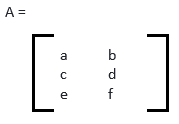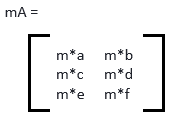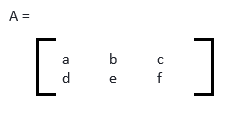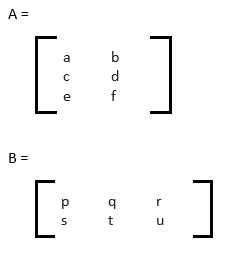In this article we will learn about two types of multiplication of matrices, multiplication of Matrix by a
scalar and Matrix multiplications (multiplication of one matrix with other matrix). We will understand
the concept by examples. Multiplication of matrix by a scalar involves multiplication of real number with matrix, whereas in matrix multiplication we multiply the entries of one matrix with the other. In this article we will learn about the steps required to be followed for the matrix multiplications and condition for the validity of matrix multiplication. Multiplication of matrix by scalar is easy but matrix
multiplication we need to be careful while multiplying the entries.
Scalars
Real numbers like 1, 2, -2 , 4,-5 etc are referred as scalars in operation of matrices.
Multiplication of Matrix by a Scalar
The multiplication of a matrix by a scalar means multiplying a matrix by any real number. In this operation, each element of the matrix is multiplied by the given real number i.e. scalar.
Let’s take a matrix A which is a square matrix i.e.
Number of rows = Number of columns.
Here, for the purpose of understanding, let’s take A as a 3 X 3 matrix and a scalar “m”.
Here a,b,c,d,e,f,g,h and i can be any number.
For example,
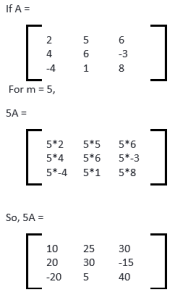
Now, let’s take a matrix A with 2 rows and 3 columns i.e. A is a 2 X 3 matrix and a scalar “m”.
To find m*A, we will multiply each element of A by m.
So,
For example,

Similarly, for a matrix A with 3 rows and 2 columns i.e. A is a 3 X 2 matrix and a scalar “m”, we have
For example,
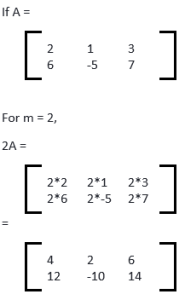
Matrix multiplications
For matrix multiplication of two matrices to work,
Number of columns of first matrix = Number of rows of second matrix.
Size of matrix obtained after multiplication will be ( number of rows of first matrix X number of columns of second matrix )
i.e if A is a 2×3 matrix and B is a 3×2 matrix then the multiplication will work because number of columns of matrix A is 3 and number of rows of matrix B is 3.
Please note that the matrix multiplication is not commutative. If we have a matrix A ( 4×3 ) and B ( 3×5 ) then , matrix multiplication AB is defined as number of columns in A is 3 and number of rows in B is also 3, but matrix multiplication BA is not defined as in that case B will be our 1st matrix and A will be our 2nd matrix, and in this case number of columns of first matrix is not equal to number of rows of matrix of second matrix.
To understand the process of multiplication let’s assume two matrices A (2×3) and B ( 3×2) .
Now we have to multiply the ROWS of A by the COLUMNS of B. For this, first take the first row of A and the first column of B, and multiply the entries individually i.e. multiply the first entry of 1st row of A by first entry 1st column of B, then the second entry of 2nd row of A by second entry of 2nd column of B, and then the third entry of 3rd row of A by third entry 3rd column of B. The sum of all these is one entry in the product matrix AB. The product of row 1 of A and column 1 of B gives (1,1) entry of AB. Then we will continue in this manner to get other terms of matrix AB. For instance, the sum of the products of 2nd row of matrix A and 1st column of B is the (2,1) entry of matrix AB.
So, “a” is first entry of 1st row of A ,“p” is first entry of 1st column of B, “b” is second entry of 1st row of A , “r” is second entry of 1st column of B, “c” is third entry of 1st row of A and “t” is third entry of 1st column of B.
To understand the process of multiplication discussed above, we will do the multiplication of A and B as follows:
a*p = multiplication of first entry of 1st row of A and first entry of 1st column of B
b*r = multiplication of second entry of 1st row of A and second entry of 1st column of B
c*t = multiplication of third entry of 1st row of A and third entry of 1st column of B
Addition of above terms gives (1,1) entry of matrix AB.
a*q = multiplication of first entry of 1st row of A and first entry of 2nd column of B
b*s = multiplication of second entry of 1st row of A and second entry of 2nd column of B
c*u = multiplication of third entry of 1st row of A and third entry of 2nd column of B
Addition of above terms gives (1,2) entry of matrix AB.
d*p = multiplication of first entry of 2nd row of A and first entry of 1st column of B
e*r = multiplication of second entry of 2nd row of A and second entry of 1st column of B
f*t = multiplication of third entry of 2nd row of A and third entry of 1st column of B
Addition of above terms gives (2,1) entry of matrix AB.
d*q = multiplication of first entry of 2nd row of A and first entry of 2nd column of B
e*s = multiplication of second entry of 2nd row of A and second entry of 2nd column of B
f*u = multiplication of third entry of 2nd row of A and third entry of 2nd column of B
Addition of above terms gives (2,2) entry of matrix AB.

Let’s understand the above process by taking real numbers as the entries of matrix elements
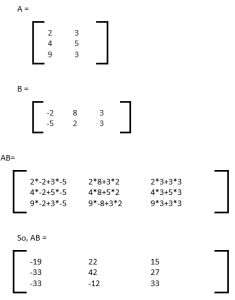
Conclusion
In the above discussions, we learned about the multiplication of a matrix by a scalar and multiplication
of two matrices. We learned that we can choose any real number as a scalar and multiplication this scalar with each entry of the given matrix gives a new matrix which is the scalar times of the original matrix. In matrix multiplication, we need to check the number of columns of the first matrix and number rows of the second matrix for the validity of matrix multiplication. The matrix multiplication is valid if these two are equal. We also learned that the new matrix has the number of rows equal to the number of rows of the first matrix and the number of columns equal to the number of columns of the second matrix.
 Profile
Profile Settings
Settings Refer your friends
Refer your friends Sign out
Sign out






